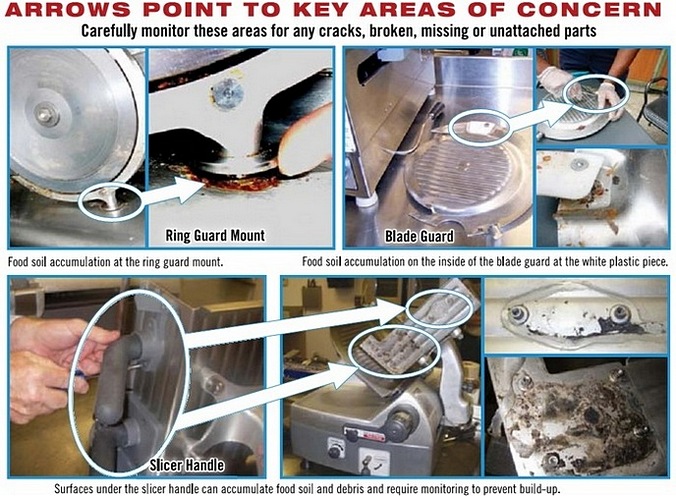Inspecting and cleaning your slicer is not a task to delay. Did you know…Food slicers commonly used in retail and foodservice establishments to slice meats, cheeses, and products may become difficult or impossible to properly clean and sanitize after a period of use. Failure to adequately clean and sanitize all surfaces of a deli slicer can contaminate food and cause illnesses or death.
- Recent outbreaks of foodborne illness have been associated with the build-up of food-soils and disease-causing microorganisms on areas of food slicers that are difficult to clean and sanitize.
- Outbreaks of serious illness and hospitalization have resulted.
- Many seams between the connected parts and components of a typical deli slicer are sealed with sealants and gaskets. These seals can become worn, degraded or even removed as a result of the heavy use and cleaning process deli slicers undergo. As these seals and gaskets become degraded, spaces can be created which can trap debris and moisture and can lead to areas that may not be able to be adequately cleaned and sanitized under normal cleaning conditions.
What can you do?
Inspect, Clean, and sanitize meat and cheese slicers per manufacturer’s instructions at least once every four hours in order to prevent the growth of disease-causing bacteria.
- Keep instructions posted near the slicer location and follow them closely.
- Simply wiping down a slicer to reduce visible debris is not a substitute for thoroughly cleaning and sanitizing the slicer.
Routinely examine the condition of seams, seals, and gaskets to confirm integrity while the slicer is assembled and before breaking down for cleaning and sanitizing.
- Inspect hard-to-reach areas for food and liquid accumulations.
If a seal or gasket is broken, missing, unattached, defective, or otherwise not performing its function, remove the slicer from service immediately and contact the slicer manufacturer for repair or replacement.
- All repairs should be performed by the manufacturer’s authorized service representative or using repair kits available from or provided by the original manufacturer.
Has the slicer professionally serviced according to the manufacturer’s recommended schedule?
- Ensure that the servicing includes an examination of all seams and the routine replacement of seals and gaskets.
- Proper servicing may require components to be removed and then reattached with the proper reapplication of sealants or gaskets.
Download a PDF of this page here.
Please visit www.fda.gov/retailfoodprotection for more information
Information originally provided by the FDA.


